
27 years
of
Community Service
of
Community Service
MUNTING NAYON
News Magazine
Operated by couple Eddie Flores and Orquidia Valenzuela
News and Views of the
Filipino Community Worldwide
Filipino Community Worldwide
A New Book on Martial Law to commemorate the 30th anniversary of the crumble of Marcos Dictatorship

By Renato Perdon
Sydney, Australia
February 15, 2016
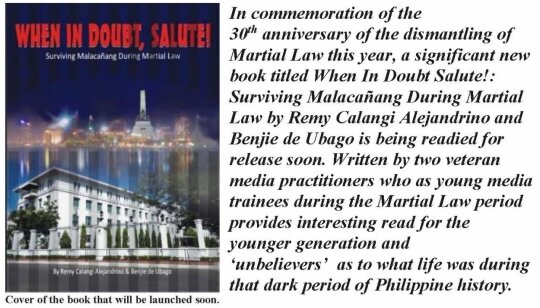
The blurb prepared for the book aptly describe it as ‘daring, provocative and unbelievable! At a time when curfews were imposed and freedom was curtailed, three young girls dared to think, questioned the system, broke the rules and defied the norms. Malacañang and the streets of Manila was their playground. This is a testimony to their adventures and their friendship that endured longer than Martial Law. It’s their story of courage and survival during Martial Law.’
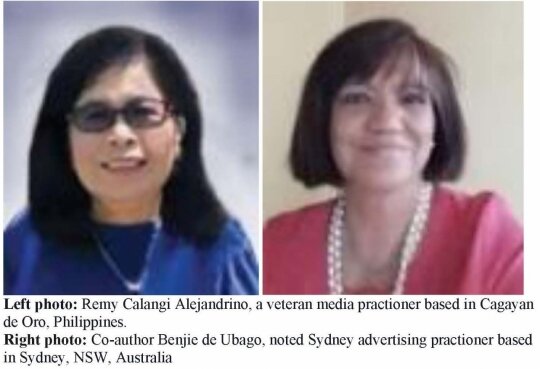
As a contemporary of the authors, I am deeply honoured to be invited to contribute a brief story of that night when the Martial Law regime crumbled and democracy in the Philippines restored. Read on and you will find your self raring to get hold of a copy of the book after reading this teaser.
The night after the People Power Revolution
By Renato Perdon,
Sydney, Australia
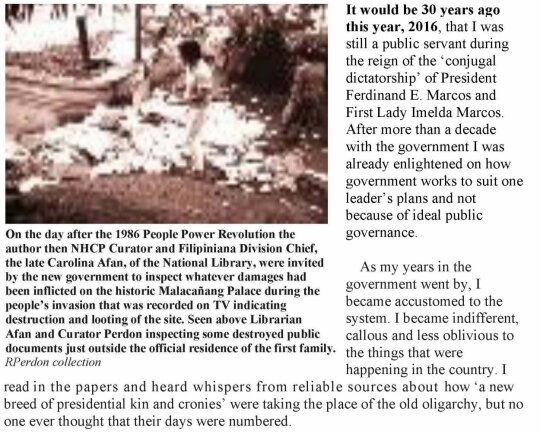
I became insensitive to issues about the Marcos regime regarding massive official graft and corruption, crony capitalism and monopolism, hidden wealth and military abuses. Added to these were the issues of excesses perpetrated by people close to the first couple, and the real issues of poverty, unemployment, and human rights violations.
So when the news of the 1986 EDSA revolution, later called the 1986 people power revolution, spread among government employees, I could no longer care. For me, no matter what the event would try to achieve, it would be just the same. Filipinos had become accustomed to the kind of lives they thought they deserved, was my reasoning.
But I underestimated that event, which I thought was just a small faction of the military complaining about their plight. What else was new, I told myself. Initially, I dismissed the situation as one of those events that would rock the administration, but would just die down and the conjugal partnership would continue as strong as ever. It was nothing new for me.
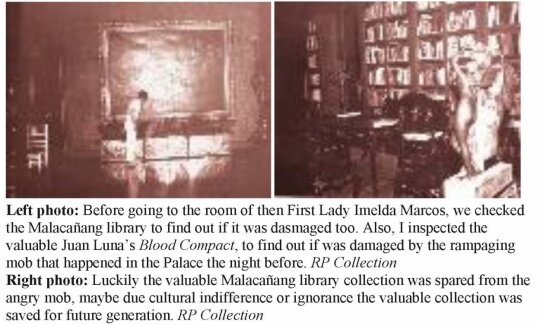
But I noticed that even the lowly employees of my office were delighted to participate in the events unfolding a few miles away from our location. I am still not sure whether they just wanted to join for fun or as an excuse not to do their work, after all they would still get paid. Many of my employees started to leave their place of work, but I stayed put, doing my job. Those who were directly under my charge asked permission to go home early because of the impending clashes between ‘fighting forces’ loyal to the Marcos administration and those against him, mainly sympathisers of General Fidel V. Ramos and National Defense Secretary Juan Ponce Enrile.
As the historic event was unfolding, I was busy at work attending to my responsibilities as a middle manager cultural administrator. By the time of the EDSA revolution, I was no longer living in Cubao, Quezon City, near where the action was taking place, but had moved to my house in Chrysanthemum Village, San Pedro, Laguna, a three bedroom, one storey government housing unit, located a stone’s throw away from Pacita Complex, a private housing project. It was about an hour trip by public transport from my new place to work.
The events that were happening at the two military camps in Quezon City were becoming tense. There was lively development and excitement, and to top it all it was not clear to many what it was all about, and why it was happening.
But as the hours went by people still joined the throng on a part of EDSA between the two military camps. Some brought food, water and softdrinks for the first group of people who were undertaking a vigil at the military camps and becoming friendly with the military.
It was the novelty of the event that was taking place and everyone had the urge to join and be part of it. There was a carnival air about what was taking place, but no one ever thought that they were making history, an important part of modern Philippine history—and indeed world history.
One journalist who wrote a book about that part of Philippine history still puzzled over why people were joining the event: ‘One can only surmise. It could be curiosity, excitement over the novelty of an event, a desire to take part in the experiment that could change one’s life, to express a grievance against one’s miserable and wretched condition, or simply an impulse to lose oneself in a crowd, or even simple pakikisama.’
The Roman Catholic Church soon joined the fray, with Cardinal Jaime Sin issuing statements that brought many Catholic followers to the site. Catholic nuns were very visible along-side military tanks stationed there who having been given orders by their military leaders, who could be General Fabian Ver, a Marcos loyalist, or General Ramos, a cousin who decided to go against Marcos—no one knows.
The public established rapport with the military soldiers, who were regarded as part of them, by giving them food, water, and flowers as a symbol of peace and brotherhood. Reports coming from the surviving operating radio station broadcast news about military battalions coming from the south and north of Manila. Were the military men joining the crowd or supporting Marcos, who at that stage was still their commander-in-chief?
Both forces were marching towards Manila. But it was not clear whether they were military men who turned their back against Marcos, or part of the group clamouring for Marcos and his family and cronies to step down and leave the country. However, there was a long wait for Marcos’ actual retreat from his holdout in Malacañang, surrounded by his family, cronies, with their own families, and members of his cabinet, who were ready to go.
In fact, downstairs at the Malacañang residence, there was a flurry of activities. Marcos loyalists were busy packing valuable things in wooden crates hurriedly prepared. They packed anything valuable that they could carry with them when the go signal to leave was given. Some Marcos loyalists and members of the household were assigned to burn official documents that would incriminate the Marcos regime.
The events started to get tense and bloody, but they were still not affecting me personally because my travel going home was far from the military camps, and from Malacañang Palace where the events were unfolding.
My way home was on the other side of the world, I might say. As usual, I went home late that day, through Baclaran where I took two jeepney rides to San Pedro, Laguna, where my mother was living with me. It was there that I watched the TV coverage of the storming of the official residence of President Ferdinand Marcos, his First Lady and his family. Although, I was not on the site when the actual invasion by the population took place, I was horrified watching the event developing into chaos and anarchy.
Describing the chaotic situation on the night the Marcosses left the country, Isabelo T. Crisostomo in his Cory: Profile of a President, said:
‘An hour after Washington confirmed that former President Marcos and his family and party had left the country…, thousands of people surged like a mighty tide into the Palace and began to ransack and pillage it. Shouting the new President’s nickname, the jubilant masses smashed their way into the white-walled, historic building, official residence of all Philippine Presidents beginning with the great and justly famous President Manuel L. Quezon. Once inside the regal Palace, the hysterical, maddened mob began to explode firecrackers, burn books, destroy furniture, hurl appliances, framed pictures, telephone sets, small cabinets and lamp posts, everything they could lay their hands on, out of the windows. Decent people who were merely curious and anxious to have a glimpse of the presidential Palace were elbowed, thrashed and trampled by the rampaging flood of ‘emancipated humanity,’ a considerable number of them represented by thieves, kleptomaniacs and the frustrated seeking to wreak vengeance on a despised leader by stealing or destroying some discarded tokens and symbols of his regime.’
The following morning I was back at work and noticed that only a few of my employees had reported for work, and many were telling stories of how they spent the night at EDSA or Malacañang Palace, where the so-called confrontation between the Marcos loyalists and the military, spearheaded by RAM, the Ramos and Enrile military-headed group, took place.
Late in the afternoon and busy at work, I got a call from the late Carol Afan, a friend and co-worker. She was an official of the National Library who was considered by many as instrumental in producing much valuable researches on Philippines history and culture. She was a nationalist and protector of Philippine culture. She was asking me to join her and two others from the National Historical Institute to document the destruction in the historic Malacañang Palace that happened the night before. The other two NHI employees were a researcher and a photographer.
But before going to Malacañang Palace, a thirty minute trip by car, our group was brought to a house in Makati which was teeming with people from all sectors of society. There I also met a former classmate, a co-fraternity member during my college days. He told me that he was settled now in Mindanao.
It was at this residence that I encountered powerbrokers for the newly installed government. It was like a market selling, not goods, but power and influence. My former classmate, knowing that I was with the group of persons very close to President Cory, asked me right there to help him secure a political place in Mindanao, where he was then a local leader. In some parts of the house, others were busy establishing the ‘right’ contacts.
I was introduced to the group by Carol Afan as being from the NHI and as one who would help document the cultural destruction that happened in Malacañang the night before.
We arrived at Malacañang Palace in a van, with other members of the group; some of them seemed to me to belong to high places. We entered the main entrance, which by that time was already under the control of the military that General Ramos had assigned to stop that ‘long night of unreined pandemonium and mob insanity as passions long seething and pent-up continued to burst into explosions of joy and hatred reminiscent of what happened as an immediate aftermath of glorious Roman conquests.’
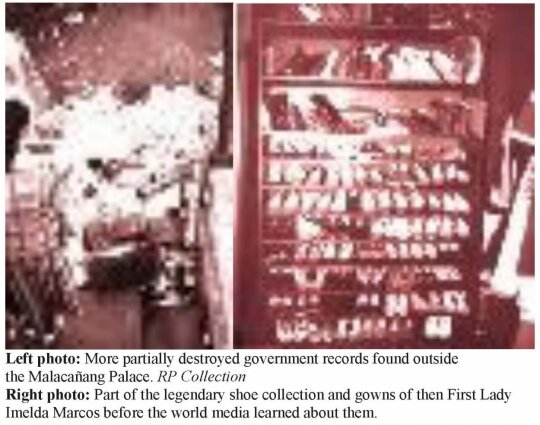
Before we started our task, we were asked to go around the Malacañang Palace grounds, and to make some photographic documentation. We went downstairs, but before going out to the grounds we found the legendary thousands of shoes owned by Imelda and expensive ternos, as well as a number of newly constructed wooden crates which were not used due to the haste in leaving the Palace.
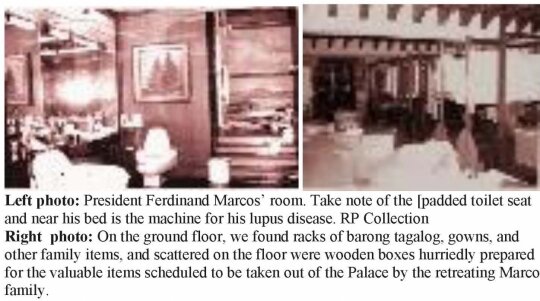
We then went to the room of Marcos and found evidence of his deteriorating health—the lupus machine and the padded toilet seat; then, the regal look of Imelda Marcos’ room mesmerized us; it was reminiscent of a room fit for a queen. It had a huge bed, with a hanging mosquito net and expensive furniture. Papers were littered everywhere. Despite the thrashing it got from the angry mob the night before, one could still see the opulence of her lifestyle.
With the photographer, we went around the ground floor and then outside, and found mounds of still smouldering official documents; some were half-burned, including bank statements, which we collected and placed in a bag.
After documenting the surroundings by NHI camera, we went to the room of Imelda where a small adjacent room was located. It was said that it was in that room where Imelda used to keep her well-known and expensive jewellery. We arrived when the other part of the group was already opening boxes of jewellery.
I noticed some of them were not just interested in making a list of the pieces of jewellery, but were more curious and excited to find out the carats or value of the jewellery they were handling and listing. Some watches had the faces of Imelda and Ferdinand Marcos, all Swiss-made.
On our part, from the ‘cultural agencies’, as official representatives of the Philippine government, we were given pens and ruled yellow paper to make itemized lists of the contents of each box of jewellery assigned to us. As the members of the group were busy with their tasks examining the jewellery—rings, necklaces, watches, brooches, earrings, and many body fashion ornaments—we concentrated on listing how many gold necklaces, rings, male or female rings, and other items there were in boxes assigned to us. We were not rushing our task, after all, we were just producing a list of the jewellery items found in that room, as big as a five-star hotel room, full of cupboards and open shelves where boxes of valuable items were stocked, some still in their original brand name boxes.
Hours later, we were told to complete our list, even unfinished, as we were leaving. I did not complete my box, so I just shoved my yellow ruled paper listing the items inside that box assigned to me. I left my box and let someone seal it with sticky tape. While looking around the room, I saw jewellery boxes were still scattered everywhere, showing that there had been a chaotic effort the night before when the Marcos retinue left, attempting to pack valuable items from the room and nearby guest room adjacent to Imelda’s bedroom.
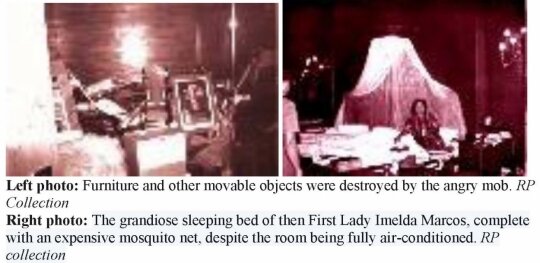
As we were leaving, the military assigned by General Ramos wanted to body search us individually for anything that we might have picked up or looted from the jewellery room. However, we all protested and told the guard we would not be body-searched. At the height of the negotiation, and to prevent any confrontation between the military and the civilian supporters of Cory, the military commander assigned to Malacañang gave way and let us go without checking us bodily.
Many of the group were happy and delighted for a job well-done. From Malacañang, we went to a house in Makati briefly, then to a small restaurant in Malate where we spent the early morning chatting and eating shabu. We were served boiling soup in which we cooked prepared pork, shrimps, beef, vegetables, fish and others. It was like a luao, without music.
The following afternoon, I got another call from Carol telling me that I was being invited again, including my photographer, to go with the group to Malacañang to continue our documentation work. Sensing that what we were doing would take a long time and not within my jurisdiction, besides having other work to do, I begged off and said that I had important tasks to complete.
Many years later, already settled in Australia, I was informed that a popular newspaper columnist revealed our group’s nocturnal visit to Macañang, the night after the downfall of the Marcos regime. I tried to get a copy of that article, to find out if he wrote truthfully about what happened during that night of ‘documenting history’ in the Palace.
In newspaper articles that were published later concerning the Imelda riches, it appeared that there were three sets of jewellery involved, and one of them refers to the jewelery cited here and having found their way into the vault of the Central Bank of the Philippines.
From The Life and Times of the Perdon Family, by Renato Perdon, Manila Prints, Sydney, Australia, 2011.
Tweet
 The chaotic Presidential election of 1986
The chaotic Presidential election of 1986
Renato Perdon
Towards the end of its twenty year rule of the Philippines, including the dreaded Martial Law period,...
 Remembering Lent in Sipocot when I was a child
Remembering Lent in Sipocot when I was a child
Renato Perdon
Sipocot in Camarines Sur in the Bicol region at that time was a booming town because of the...
 A New Book on Martial Law to commemorate the 30th anniversary of the crumble of Marcos Dictatorship
A New Book on Martial Law to commemorate the 30th anniversary of the crumble of Marcos Dictatorship
Renato Perdon
...
 APCO joins ECC at 2016 Premier’s Harmony Dinner
APCO joins ECC at 2016 Premier’s Harmony Dinner
Richard J Ford
The Alliance of Philippine Community Organisations Inc. (APCO) joined forces with Ethnic Communities Council of NSW (ECC NSW INC) at this year’s Premier’s Harmony Dinner. Thirty two members and officers of APCO accepted the offer of ECC NSW to its members at a reduced cost of $75/person for bookings processed through the ECC office. APCO on the other hand, also...
 ISLANDERS CHEER CLASSICAL GUITARIST
ISLANDERS CHEER CLASSICAL GUITARIST
Pablo A. Tariman
VIRAC, CATANDUANES -- Classical guitarist Aemilio Cecilio Enginco attracted more converts for classical guitar after he opened the 2016...
 DURHAM CROSSOVER COMES HOME WITH PRIDE
DURHAM CROSSOVER COMES HOME WITH PRIDE
Li ERON
As we remember, DURHAM Crossover went home to Philippines to compete at SM NBTC HIGH SCHOOL CHAMPIONSHIP FINALS...
 Miss Universe Shares Uplifting Message for International Women's Day
Miss Universe Shares Uplifting Message for International Women's Day
Michelle Chermaine Ramos
During her brief visit in Toronto, Miss Universe 2015 Pia Wurtzbach shared her personal experience dealing with cyber bullies growing...
 EXPLOSIONS IN BRUSSELS AIRPORT AND MAALBEEK METRO STATION
EXPLOSIONS IN BRUSSELS AIRPORT AND MAALBEEK METRO STATION
Philippine Embassy – Brussels
The Philippine Embassy in Brussels advises Filipinos in Belgium to heed advisories of local authorities in view of today’s explosions...
 The 1st Filipino Workers’ Network Conference in Toronto, Canada to be held on April 9, 2016
The 1st Filipino Workers’ Network Conference in Toronto, Canada to be held on April 9, 2016
Paulina Corpuz
...
 The chaotic Presidential election of 1986
The chaotic Presidential election of 1986
Renato Perdon
Towards the end of its twenty year rule of the Philippines, including the dreaded Martial Law period,...
- Remembering Lent in Sipocot when I was a child
- 67 FILIPINO COMMUNITY ORGANIZATIONS IN U.S. NORTHEAST SET STAGE FOR STRONGER COMMUNITY AT 2nd GENERAL ASSEMBLY
- MSP ADVISES VOTERS ON DEADLINE FOR BALLOT REQUEST BY MAIL
- NYPAA SETS SPRING OFFICERS INDUCTION and FUNDRAISER
- FilCan Catholic Parents Association Slates Annual Parents, Students & Teachers Conference
- CAUSE AND EFFECT
- Knights of Rizal (KOR) Sydney Chapter Elects New Officers for RYs 2016-2018
- Soli Navarro's 85th Birthday
- HOME AWAY FROM HOME - (Part 6)
- Knights of Columbus KC # 2113 Blessing of the Sword St. Aidan Church, Scarborough, Ontario
- The Great Gatsby Party In The Netherlands….Evans Laure turned 50 with glitter and glamour!
- The Philippine's RETrosPECT Band Performs in Toronto
- Shakba Team bagged Championship, Mahid Tago won MVP Title at RSC 1st Inter-Maranao Basketball Conference
- Just Another Sunday
- FilCan Immigrants Group Launches Migrante Partylist in Toronto
- Toronto FilCan Educators Slate Professional Development Seminar
- POST-ARRIVAL ORIENTATION SEMINAR CONDUCTED AT THE PHILIPPINE BAYANIHAN CENTRE IN SINGAPORE
- LOCAL ARTISTS SIZZLED FOR A CAUSE IN MARKHAM
- MAP Seminar reaches XU-Ateneo de Cagayan
 `CON AMOR’ FOUNDATION B0ARD MEMBERS VISIT PROJECTS IN PHILIPPINES
`CON AMOR’ FOUNDATION B0ARD MEMBERS VISIT PROJECTS IN PHILIPPINES
By: Orquidia. Valenzuela, as reported by Myrla Danao
Businessman Jaap van Dijke, chairman and two board members, Myrla Danao and Dr. John Deen of Con Amor foundation in...
 Art Creations
Art Creations
Vicente Collado Jr.
Welcome!
Many believe formal training is a prerequisite to quality in painting. Not a few will agree with me one can...
 THE CHILDREN IN DON MANUEL GK VILLAGE
THE CHILDREN IN DON MANUEL GK VILLAGE
Orquidia Valenzuela Flores
Sixty-three children from age three to six years, in the very poor community of Don Manuel village in Barangay...
Contents posted in this site, muntingnayon.com, are the sole responsibility of the writers and do not reflect the editorial position of or the writers' affiliation with this website, the website owner, the webmaster and Munting Nayon News Magazine.
This site, muntingnayon.com, the website owner, the webmaster and Munting Nayon News Magazine do not knowingly publish false information and may not be held liable for any direct, indirect, incidental, consequential or punitive damages arising for any reason whatsoever from this website or from any web link used in this site.

